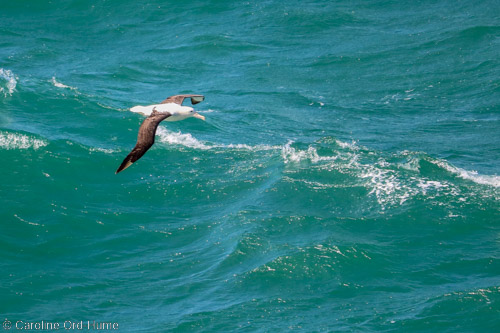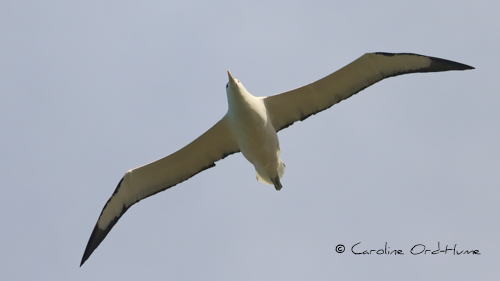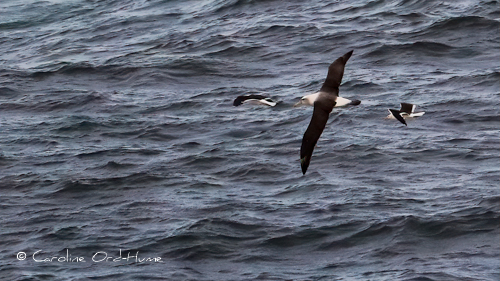New Zealand Albatross / Toroa / Diomedeidae
There are 17 species of New Zealand Albatross with 12 of those that breed in New Zealand, including Royal Albatross. There is one additional extinct Albatross species.
Northern Royal Albatross (Diomedea sanfordi), Otago Peninsula, Dunedin, New Zealand

Considering that there are just 23 species of Albatross in the world, having 17 species of Albatross in New Zealand is a good percentage of the varieties although some are migrants or vagrants and breed elsewhere in the world.
As Albatrosses spend most of their life out at sea you are unlikely to just happen across these birds on the mainland.. Some Albatross species can be seen at specific locations in New Zealand and surrounding islands and seas, and some are rare and/or in danger due to low numbers.
Probably the most commonly known Albatross of New Zealand are the Northern Royal Albatross, although that doesn't necessarily mean they are the highest in numbers.
There is an Albatross Centre on the Dunedin Otago Peninsula where visitors can see Northern Royal Albatross at the only mainland Albatross nesting colony in the world. This is the best place to see and appreciate New Zealands Albatross as they fly low overhead and glide through the air over the sea around the peninsula.
New Zealand Albatross Bird Species List
Scroll for full list of Albatross in New Zealand. List is alphabetical and in no particular order whether common or rare bird species.
Diomedeidae is the family name of all the Albatross listed below.
Antipodean Albatross - Diomedea antipodensis
Conservation: Species is in a nationally critical conservation status.
Other Common Names: Wandering Albatross, Toroa, Gibson's Albatrosss.
Atlantic Yellow-nosed Mollymawk - Thalassarche chlororhynchos
Conservation: Species is vagrant.
Other Common Names: Yellow-nosed Mollymawk, Western Yellow-nosed Mollymawk, Atlantic Yellow-nosed Albatross, Western Yellow-nosed Albatross, Yellow-nosed Albatross.
Black-browed Mollymawk - Thalassarche melanophris
Conservation: Species is a coloniser.
Other Common Names: Black-browed Albatross.
Black-footed Albatross - Phoebastria nigripes
Conservation: Species is vagrant.
Other Common Names: Ka'upu (Hawaiian).
Buller's Mollymawk - Thalassarche bulleri
Conservation: Species is uncommon.
Other Common Names: Buller's Albatross, Toroa, Pacific Mollymawk, Pacific Albatross.
Campbell Black-browed Mollymawk - Thalassarche impavida
Conservation: Species is in a nationally vulnerable conservation status.
Other Common Names: Campbell Black-browed Albatross, Campbell Island Mollymawk, Campbell Island Albatross, Toroa, Black-browed Mollymawk, Black-browed Albatross, Campbell Mollymawk, Campbell Albatross.
Chatham Island Mollymawk - Thalassarche eremita
Conservation: Species is uncommon.
Other Common Names: Chatham Island Albatross, Toroa, Chatham Mollymawk, Chatham Albatross.
Grey-headed Mollymawk - Thalassarche chrysostoma
Conservation: Species is in a nationally vulnerable conservation status.
Other Common Names: Grey-headed Albatross.
Indian Ocean Yellow-nosed Mollymawk - Thalassarche carteri
Conservation: Species is a Coloniser.
Other Common Names: Indian Ocean Yellow-nosed Albatross, Toroa, Eastern Yellow-nosed Mollymawk, Carter's Mollymawk, Yellow-nosed Albatross.
Laysan Albatross - Phoebastria immutabilis
Conservation: Species is vagrant.
Light-mantled Sooty Albatross - Phoebetria palpebrata
Conservation: Species is in decline.
Other Common Names: Light-mantled Albatross, Toroa, Toroa pango, Toroa-a-ruru, Koputu.
Northern Royal Albatross - Diomedea sanfordi
Conservation: Species is uncommon naturally.
Other Common Names: Toroa, Royal Albatross.
Northern Royal Albatross (Diomedea sanfordi), South Island, NZ

Salvin's Mollymawk - Thalassarche salvini
Conservation: Species is in a nationally critical conservation status.
Other Common Names: Salvin's Albatross, Toroa, Bounty Island Mollymawk, Grey-backed Mollymawk.
Sooty Albatross - Phoebetria fusca
Conservation: Species is a vagrant. There appears to be only 4 recorded sightings at the time of writing.
Southern Royal Albatross - Diomedea epomophora
Conservation: Species is uncommon naturally.
Other Common Names: Toroa.
Wandering Albatross - Diomedea exulans
Conservation: Wandering Albatross is a migrant species.
Other Common Names: Snowy Albatross, Toroa.
White-capped Mollymawk - Thalassarche cauta
Conservation: Species is in decline.
Other Common Names: White-capped Albatross, Toroa, Shy Mollymawk, Shy Albatross.
White-capped Mollymawk (Thalassarche cauta), Albatross, Otago Peninsula, Dunedin, New Zealand

Extinct New Zealand Albatross
Alastair's Albatross - Aldiomedes Angustirostris
Conservation: Extinct. Sadly this species no longer exists.
You may also like...
List of native New Zealand birds and a wildlife of New Zealand
New Zealand Albatross Conservation and Law
At the time of writing… any New Zealand Albatross found injured or in distress should be reported directly to the Department of Conservation in the first instance. The Department will make arrangements for any bird in New Zealand to receive appropriate treatment. Data will also be recorded that will assist in future conservation planning such as the type of injury and place where the bird was found. Should a number of birds be getting injuries or be found dead in a particular location it may be related to a specific cause such as dog attacks.